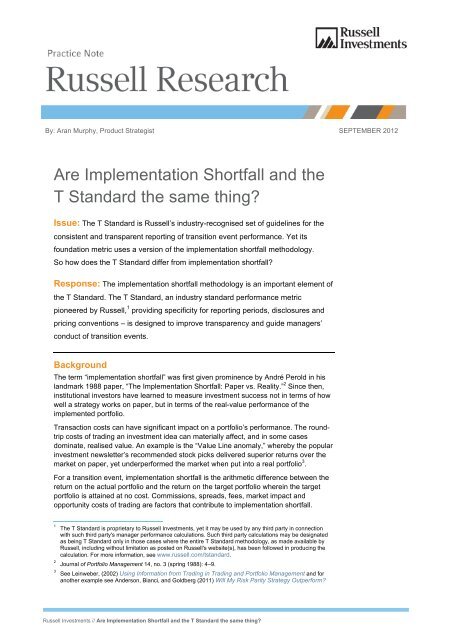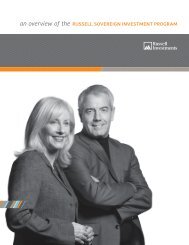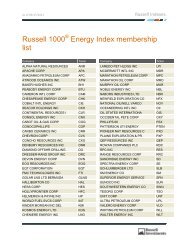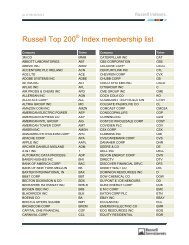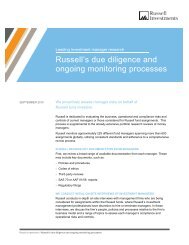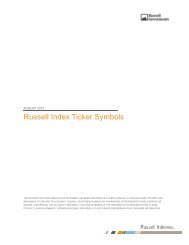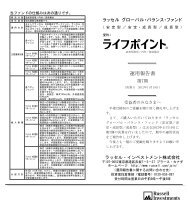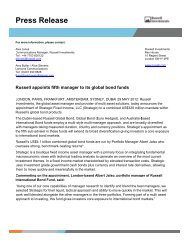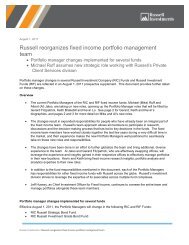Are Implementation Shortfall and the T Standard the same thing?
Are Implementation Shortfall and the T Standard the same thing?
Are Implementation Shortfall and the T Standard the same thing?
Create successful ePaper yourself
Turn your PDF publications into a flip-book with our unique Google optimized e-Paper software.
By: Aran Murphy, Product Strategist SEPTEMBER 2012<br />
<strong>Are</strong> <strong>Implementation</strong> <strong>Shortfall</strong> <strong>and</strong> <strong>the</strong><br />
T St<strong>and</strong>ard <strong>the</strong> <strong>same</strong> <strong>thing</strong>?<br />
Issue: The T St<strong>and</strong>ard is Russell’s industry-recognised set of guidelines for <strong>the</strong><br />
consistent <strong>and</strong> transparent reporting of transition event performance. Yet its<br />
foundation metric uses a version of <strong>the</strong> implementation shortfall methodology.<br />
So how does <strong>the</strong> T St<strong>and</strong>ard differ from implementation shortfall?<br />
Response: The implementation shortfall methodology is an important element of<br />
<strong>the</strong> T St<strong>and</strong>ard. The T St<strong>and</strong>ard, an industry st<strong>and</strong>ard performance metric<br />
pioneered by Russell, 1 providing specificity for reporting periods, disclosures <strong>and</strong><br />
pricing conventions – is designed to improve transparency <strong>and</strong> guide managers’<br />
conduct of transition events.<br />
Background<br />
The term “implementation shortfall” was first given prominence by André Perold in his<br />
l<strong>and</strong>mark 1988 paper, “The <strong>Implementation</strong> <strong>Shortfall</strong>: Paper vs. Reality.” 2 Since <strong>the</strong>n,<br />
institutional investors have learned to measure investment success not in terms of how<br />
well a strategy works on paper, but in terms of <strong>the</strong> real-value performance of <strong>the</strong><br />
implemented portfolio.<br />
Transaction costs can have significant impact on a portfolio’s performance. The roundtrip<br />
costs of trading an investment idea can materially affect, <strong>and</strong> in some cases<br />
dominate, realised value. An example is <strong>the</strong> “Value Line anomaly,” whereby <strong>the</strong> popular<br />
investment newsletter’s recommended stock picks delivered superior returns over <strong>the</strong><br />
market on paper, yet underperformed <strong>the</strong> market when put into a real portfolio 3 .<br />
For a transition event, implementation shortfall is <strong>the</strong> arithmetic difference between <strong>the</strong><br />
return on <strong>the</strong> actual portfolio <strong>and</strong> <strong>the</strong> return on <strong>the</strong> target portfolio wherein <strong>the</strong> target<br />
portfolio is attained at no cost. Commissions, spreads, fees, market impact <strong>and</strong><br />
opportunity costs of trading are factors that contribute to implementation shortfall.<br />
1<br />
2<br />
3<br />
The T St<strong>and</strong>ard is proprietary to Russell Investments, yet it may be used by any third party in connection<br />
with such third party's manager performance calculations. Such third party calculations may be designated<br />
as being T St<strong>and</strong>ard only in those cases where <strong>the</strong> entire T St<strong>and</strong>ard methodology, as made available by<br />
Russell, including without limitation as posted on Russell's website(s), has been followed in producing <strong>the</strong><br />
calculation. For more information, see www.russell.com/tst<strong>and</strong>ard.<br />
Journal of Portfolio Management 14, no. 3 (spring 1988): 4–9.<br />
See Leinweber, (2002) Using Information from Trading in Trading <strong>and</strong> Portfolio Management <strong>and</strong> for<br />
ano<strong>the</strong>r example see Anderson, Bianci, <strong>and</strong> Goldberg (2011) Will My Risk Parity Strategy Outperform?<br />
Russell Investments // <strong>Are</strong> <strong>Implementation</strong> <strong>Shortfall</strong> <strong>and</strong> <strong>the</strong> T St<strong>and</strong>ard <strong>the</strong> <strong>same</strong> <strong>thing</strong>?
While <strong>the</strong> implementation shortfall methodology is a general measure of transaction<br />
costs, <strong>the</strong> T St<strong>and</strong>ard is a specific measure used for <strong>the</strong> consistent <strong>and</strong> transparent<br />
reporting of transition event performance. Although <strong>the</strong> implementation shortfall<br />
methodology is an important element of <strong>the</strong> T St<strong>and</strong>ard, <strong>the</strong> T St<strong>and</strong>ard sets out<br />
stronger guidelines for reporting periods, disclosures <strong>and</strong> pricing conventions. One can<br />
do an implementation shortfall calculation <strong>and</strong> not necessarily get <strong>the</strong> T St<strong>and</strong>ard result<br />
– but one can’t get <strong>the</strong><br />
T St<strong>and</strong>ard result without doing an implementation shortfall calculation.<br />
Russell’s motivation for creating <strong>the</strong> T St<strong>and</strong>ard 4<br />
The reporting clients look for, <strong>and</strong> which <strong>the</strong>ir managers provide during <strong>the</strong>ir ongoing<br />
investment assignments, is time-weighted investment performance data derived from<br />
<strong>the</strong> managers’ accounting systems. The reporting protocol in transition management<br />
assignments should be no different. Reports should provide daily returns, include all<br />
assets <strong>and</strong> include day-over-day market valuation.<br />
For <strong>the</strong> above reasons, Robert Collie of Russell Investments built an industry<br />
consensus on <strong>the</strong> proper st<strong>and</strong>ards for transition management performance - from <strong>the</strong><br />
client’s perspective. 5 The new st<strong>and</strong>ard, called <strong>the</strong> T St<strong>and</strong>ard, established a rule<br />
whereby transition managers provide daily, accounting-system-based market<br />
valuations of all portfolio assets (including cash, securities, currency, derivatives <strong>and</strong><br />
o<strong>the</strong>r relevant assets). Reporting must show how <strong>the</strong> returns tie out to <strong>the</strong> three key<br />
periods of <strong>the</strong> transition: pre-implementation, implementation <strong>and</strong> post-implementation.<br />
Exhibit 1 / The implementation shortfall measure <strong>and</strong> <strong>the</strong> T St<strong>and</strong>ard – a comparison<br />
IMPLEMENTATION SHORTFALL<br />
A methodology first articulated by<br />
André Perold<br />
in 1988<br />
Measures <strong>the</strong> difference between a<br />
trade or portfolio’s return on paper <strong>and</strong><br />
<strong>the</strong> real return realised after trading<br />
Generalised for all transactions<br />
What is measured can vary<br />
immensely, with different managers<br />
providing different arrival prices,<br />
benchmark rules <strong>and</strong> reporting periods<br />
T STANDARD<br />
A set of reporting practices introduced<br />
by Russell Investments in 2003<br />
Measures <strong>the</strong> difference between a<br />
transition portfolio’s value on <strong>the</strong> close<br />
prior to trading <strong>and</strong> <strong>the</strong> portfolio value<br />
at conclusion of trading<br />
Specific to transition management<br />
industry<br />
The T St<strong>and</strong>ard is now industry<br />
st<strong>and</strong>ard, with consistent pricing <strong>and</strong><br />
reporting frameworks<br />
The T St<strong>and</strong>ard follows methodology<br />
used in ongoing asset management<br />
assignments<br />
4<br />
5<br />
The T St<strong>and</strong>ard was first introduced in 2003 by R Collie of Russell Investments. See R Collie, “Calculating<br />
Investment Performance During a Portfolio Transition: The ‘T St<strong>and</strong>ard’”, Russell Research Practice Note,<br />
2007. It was <strong>the</strong>n updated in 2008 to include more examples <strong>and</strong> clarification on timing, changes to <strong>the</strong><br />
target portfolio during <strong>the</strong> implementation, <strong>and</strong> allowable prices. For more information click here.<br />
R. Collie, “Performance St<strong>and</strong>ards for Transition Management”, Journal of Performance Measurement 2003.<br />
Russell Investments // <strong>Are</strong> <strong>Implementation</strong> <strong>Shortfall</strong> <strong>and</strong> <strong>the</strong> T St<strong>and</strong>ard <strong>the</strong> <strong>same</strong> <strong>thing</strong>? / p 2
T St<strong>and</strong>ard performance summary – an example<br />
The image below is an attribution report that breaks down <strong>the</strong> performance of a<br />
transition event. <strong>Implementation</strong> shortfall, as defined in this case by <strong>the</strong> T St<strong>and</strong>ard, is<br />
but one dimension by which <strong>the</strong> success of <strong>the</strong> event is gauged.<br />
T St<strong>and</strong>ard<br />
performance summary<br />
Pre-implementation<br />
period<br />
<strong>Implementation</strong><br />
period<br />
Post-implementation<br />
period<br />
Time-w eighted<br />
return<br />
05-Dec - 07-Dec 08-Dec - 13-Dec 14-Dec - 14-Dec 05-Dec - 14-Dec<br />
Legacy portfolio -0.82% -3.84% -2.03% -6.56%<br />
Transition portfolio -0.82% -2.76% -1.28% -4.78%<br />
Target portfolio -0.04% -2.41% -1.27% -3.69%<br />
RUSSELL MIDCAP INDEX -0.45% -3.69% -1.35% -5.42%<br />
<strong>Implementation</strong> shortfall -0.34%<br />
Actual transaction costs -0.35%<br />
Opportunity gain 0.01%<br />
Legacy portfolio Transition portfolio Target portfolio RUSSELL MIDCAP INDEX<br />
0.00%<br />
-1.00%<br />
-2.00%<br />
-3.00%<br />
-4.00%<br />
-5.00%<br />
-6.00%<br />
-7.00%<br />
Pre-implementation<br />
period<br />
<strong>Implementation</strong><br />
period<br />
Post-implementation<br />
period<br />
Time-weighted<br />
return<br />
For illustrative purposes only.<br />
Includes commissions, taxes & fees, bid/ask spread, market impact <strong>and</strong> opportunity costs.<br />
Data is historical <strong>and</strong> not a guarantee of future results. Indexes are unmanaged <strong>and</strong> cannot be invested in directly.<br />
The T St<strong>and</strong>ard evolved as a means of better evaluating <strong>and</strong> managing large portfolio<br />
changes, such as an institutional investor’s funding, hiring or firing of an investment<br />
manager. Unmanaged transitions were known to be costly, <strong>and</strong> yet until <strong>the</strong> T<br />
St<strong>and</strong>ard, <strong>the</strong>re was little consensus on how best to measure investment performance<br />
during a transition. True daily investment performance measurement, key to<br />
management throughout a transition event, was relatively unknown. Now, with <strong>the</strong> T<br />
St<strong>and</strong>ard, institutional investors have a transparent <strong>and</strong> consistent means of assessing<br />
<strong>the</strong> impact of changing a portfolio’s structure.<br />
Russell Investments // <strong>Are</strong> <strong>Implementation</strong> <strong>Shortfall</strong> <strong>and</strong> <strong>the</strong> T St<strong>and</strong>ard <strong>the</strong> <strong>same</strong> <strong>thing</strong>? / p 3
A detailed daily view into your portfolios<br />
For illustrative purposes only.<br />
Data is historical <strong>and</strong> not a guarantee of future results. Indexes are unmanaged <strong>and</strong> cannot be invested in directly.<br />
RELATED READING<br />
For more information about <strong>the</strong> T St<strong>and</strong>ard <strong>and</strong> transition management, please visit<br />
Russell Investments’ website, at www.russell.com/tm, www.russell.com/tst<strong>and</strong>ard, <strong>and</strong><br />
www.russell.com/institutional/investment_solutions/transition_best_practices.asp<br />
Important Information: This document is issued by Russell Investment Management Ltd ABN53 068 338 974, AFS License 247185 (RIM). It provides<br />
general information for wholesale investors only <strong>and</strong> has not prepared having regard to your objectives, financial situation or needs. Before making an<br />
investment decision, you need to consider whe<strong>the</strong>r this information is appropriate to your objectives, financial situation or needs. This information has been<br />
compiled from sources considered to be reliable, but is not guaranteed. Past performance is not a reliable indicator of future performance. No<strong>thing</strong><br />
contained in this material is intended to constitute legal, tax, securities, or investment advice, nor an opinion regarding <strong>the</strong> appropriateness of any<br />
investment, nor a solicitation of any type. Copyright © 2012 Russell Investments. All rights reserved. This material is proprietary <strong>and</strong> may not be<br />
reproduced, transferred, or distributed in any form without prior written permission from RIM or Russell Investments. First published July 2012. Revised<br />
September 2012. R_RPT_RES_<strong>Shortfall</strong>TSt<strong>and</strong>ard_V1F_1209 MKT/4910/0912<br />
Russell Investments // <strong>Are</strong> <strong>Implementation</strong> <strong>Shortfall</strong> <strong>and</strong> <strong>the</strong> T St<strong>and</strong>ard <strong>the</strong> <strong>same</strong> <strong>thing</strong>? / p 4


